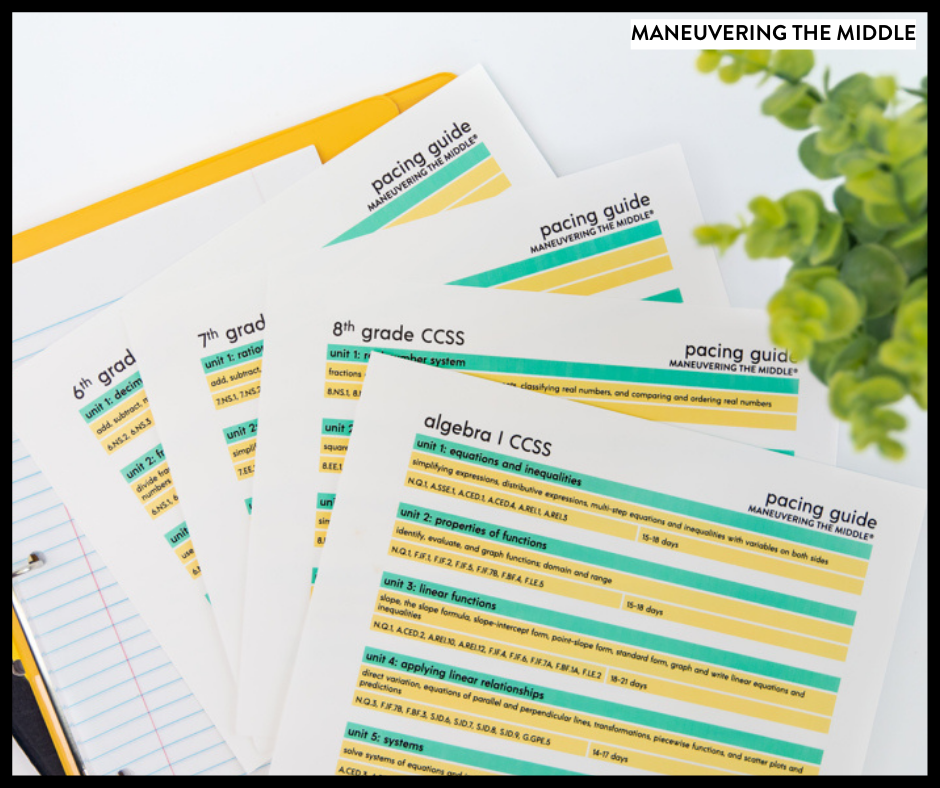As a teacher, getting behind in your scope and sequence can feel especially stressful. These tips will keep you on track so when it comes to test review time in the spring, you have covered all of your material, and you aren’t rushing to fit it all in and trying to review too!

1. Use a Scope and Sequence (grab ours!)
If you fail to plan, you plan to fail. If you aren’t provided a scope and sequence by your school, or if you haven’t made one yourself, the task of organizing 50+ math standards into 180 instructional days can be daunting.
Download our free pacing guides for 6th, 7th, 8th grade math, and Algebra 1!
You can see how our Maneuvering the Middle curriculum organizes the standards. From there, download a calendar on Google Sheets, fill in district holidays and professional development days, and work backwards from your state test.
2. Give Yourself Some Cushion
When planning for a unit, give a minimum of 3 days for cushion. No new material is introduced on these days. You can use these days for review, extra practice, or reteaching content that the majority of your students did not master prior.
In a unit that is 15 days long, I would have one day for reviewing before the unit test, one day for an activity followed by a short quiz, and one additional day for an extra challenging skill that required more practice. That means that out of 5 days of the week, on average, I am only teaching new content 4 of those days.
3. Be Familiar with Vertical Planning
The first year I taught 6th grade math, ordering rational numbers was in my first unit. My district provided a unit plan that gave me one day to teach this very complicated concept. When we got to ordering decimals and fractions, I modeled how to divide in order to convert fractions into decimals. My highest students raised their hands in protest – “You can’t divide a smaller number by a larger number!” Students lost their minds. That didn’t even include all of the students who forgot the standard algorithm for division. I was trying to cover too much in one lesson!
The lesson I learned that day was this – you need to know what your students already know and don’t know to successfully introduce new concepts. This will come in time, but take a moment to read vertical planning documents (provided in our All Access curriculum). This will prevent you from wasting entire days because you have to pivot on the fly.
4. Formative Assessments Keep You On Track
Knowing how your students are actually doing with the skills they are learning is paramount to staying on schedule each year. I recommend a daily formative assessment on the material covered that day while it is fresh. This can be a 2 question exit ticket or it can be as simple as collecting their classwork and checking problem #5. I like to keep these open-ended (why do students love to just circle multiple-choice answers?!). These are not always graded assignments; they are simply problems that tell me if I can move on to new material the next day or if we need to spend an extra day on the material.
What you are trying to avoid is students making it all the way to the unit test only to bomb spectacularly, and then you are bewildered and overwhelmed trying to plan next steps.
5. Save the fun stuff for the alternative schedule days
I love when you can make math applicable to the real world! Projects or performance tasks are awesome! I like to save these types of assignments for days where the schedule is already a little crazy. This usually falls before holiday breaks, after pep rallies or on early release days. This is also when there are various field trips, students are more likely to be absent, and it doesn’t really make sense to cover new material. (Which leads me to a side rant that Fridays are also a bad day to cover new skills.)
Projects and performance tasks are a great way to spiral previous learned standards, so it provides a fun way to review.
6. Don’t Waste a Day for Absences
Don’t waste a single day! With an All Access membership, your students don’t have to lose an instructional day because you are sick or need to take a personal day. The student videos cover the student handouts. Instruction can continue even when you are absent!
7. Consider a Self-Paced Classroom
If your students have a wide range of abilities, you may want to consider a self-paced classroom. We have two blog posts and podcast episodes that I highly recommend checking out if you are interested in letting students work at their own speed (What is the Grid Method? | The Self-Paced Classroom).
Students who need more time to master a skill can receive more of your attention since students who have already mastered a skill can move on without you.
8. Sometimes You Need to Move On
As teachers, I believe that the ideal state is for 100% of students to master 100% of the concepts that we teach. This is not the reality we live in but we can work toward it. However, 100% of our students will master 0% of the concepts that we don’t teach.
Teachers have to cover all of the material in roughly 180 instructional days. I know it can feel impossible some days, but you can do it! If you find yourself stuck in a unit and the majority of your students are truly struggling, then maybe you need to revisit the material at a later date. Maybe your students are fatigued by the skill and moving onto something new will give them the mental clarity to try it again.
How do you stay on track with your scope and sequence during the school year?




